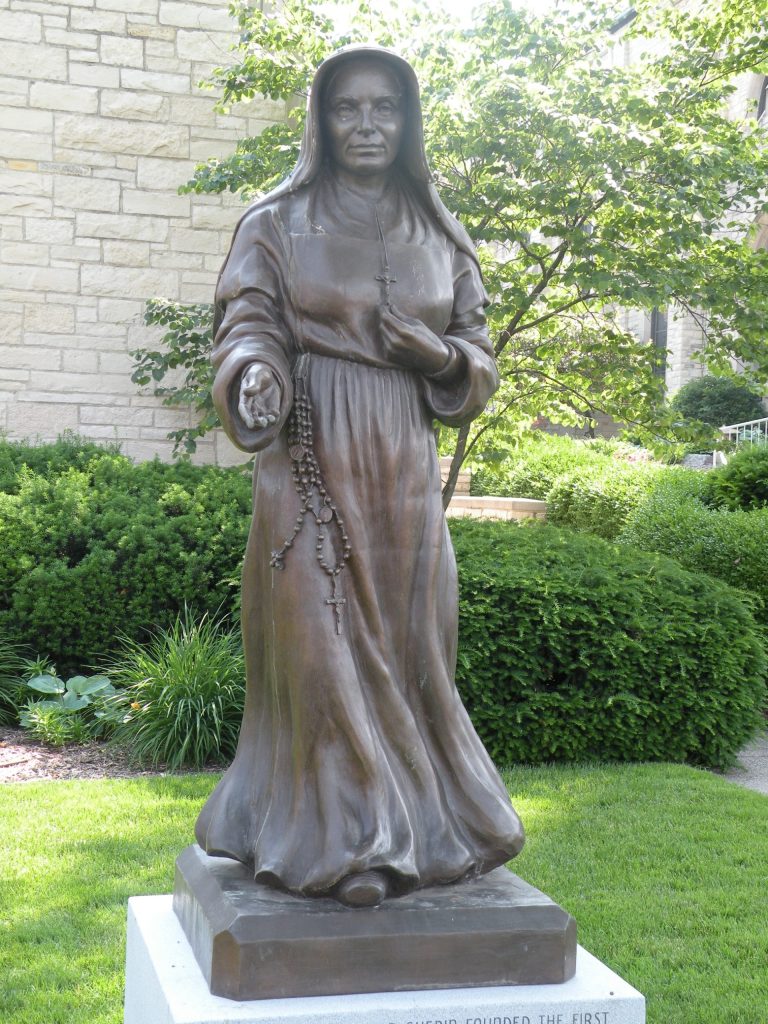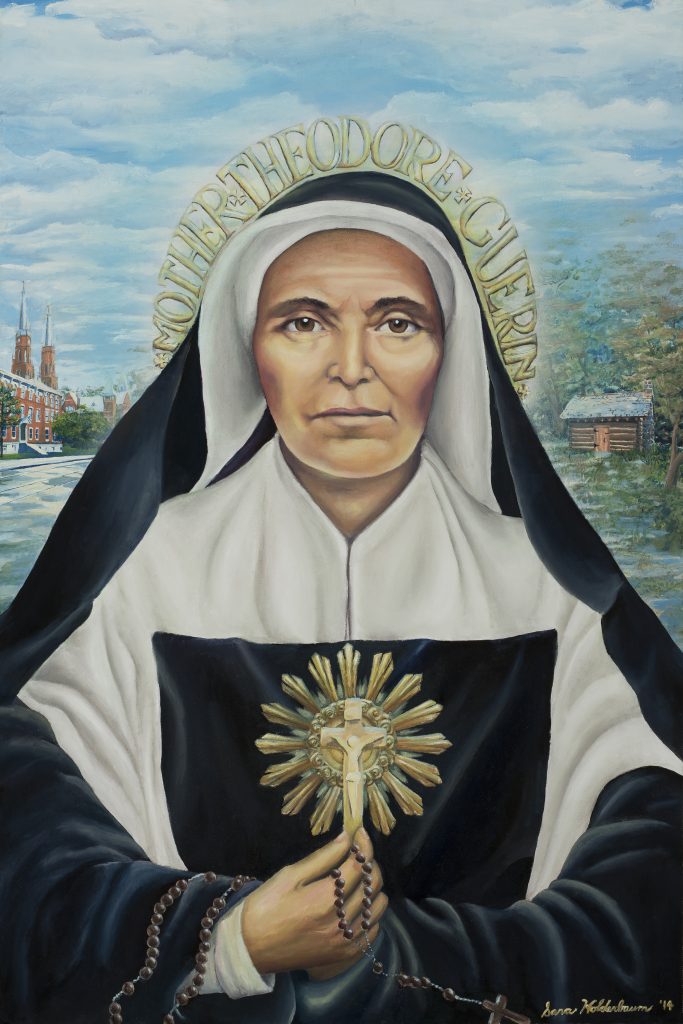March 20, 2024 // Diocese
The Life and Legacy of St. Mother Theodore Guerin
St. Mother Theodore Guerin, foundress of the Sisters of Providence of Saint-Mary-of-the-Woods near Terre Haute, described spring in Indiana with awe. She said, “The beauty of the forests of Indiana in the rich and lovely month of May surpasses all description.” Guerin is one of the few Catholic Saints who called the United States home. As the Church and the world mark Women’s History Month, we celebrate the lasting impact Mother Guerin made across Indiana and the Midwest, where she established parish schools, including in Fort Wayne. Her story, though, did not begin in the beauty of the Indiana forests but rather in a small village of Étables on the English Channel in France.
Étables, a quaint coastal town nestled in northern France, boasts a captivating charm with its winding streets and historic buildings. In the 1790s, it stood south of a bustling port city, maintaining its picturesque allure. Perched by the sea, Étables offered cliffs framing the English Channel, dramatic storms, and a serene village ambiance. Many households had flourishing gardens, sustaining the locals through commerce; the predominant occupations revolved around maritime pursuits.
In the late 1780s and early 1790s, France was a turbulent environment. Fortunately, by the time Guerin was born, France had calmed, but perhaps not in the sense many residents desired. Robert Tombs, a French historian, properly described this sense of calm. He wrote: “Every regime was the target of assassination attempts of a frequency that put Spanish and Russian politics in the shade. Even in peaceful times, governments changed every few months. In less peaceful times, political deaths, imprisonments, and deportations are literally incalculable.” While the small, peaceful village of Étables might have achieved some version of stability, the country at large lacked it.
The story of Anne-Therese Guerin, now known as St. Mother Theodore Guerin, is planted in this history. She was born from a marriage between the Guerin and Lefevre families. Yet, the relationship built between the two families could not have been more representative of the times in France. Laurent, Ann-Therese’s father, came from a family of royalists, while her mother’s family supported Napoleon Bonaparte, the future Emperor of France. Therefore, friends and family met this marriage with bitterness.
Despite the family feud, Laurent and her mother, Isabelle, embraced life together and brought four children into this world. Ann-Therese was born first; the addition of two brothers and one more sister made the family complete. While this union began peacefully, tragedy eventually struck. One of Ann-Therese’s brothers died in infancy, and another passed away in a tragic fire at the age of 7.
From a young age, it was primarily Ann-Therese, her sister, and her mother in the home. Her father was often away for months at a time – even years – because he served as a naval officer with the French Empire. This position secured the family financially but inevitably limited the opportunity to be together often. Therefore, the women managed their home that bordered the sea – a house with large windows looking east out into the Channel.
This view of the sea affected Guerin’s religious life. In a 1904 biography of her, the author wrote, “Having once learned that the vastness of the sea is an image of the immensity of Him who sets its bounds, she could never look upon the water without fixing her thoughts upon that blessed home beyond the sea of time and experiencing a longing for things that were not of earth, a longing which increased as she advanced in years, and which laid the foundation for that contemplative and meditative spirit which was habitual to her in later life.”
As a child, Guerin was smart and made her desire to live a religious life known as early as her first communion. By age 12, her life was centered around her mother, sister, and community. Yet, she always longed for her father, who had joined the French Empire with Napoleon in the Iberian Peninsula to conquer Spain and Portugal. War began when Spain and France, both allies, invaded Portugal, a dwindling world power at the time; Napoleonic France installed Joseph Bonaparte as the King of Spain, ultimately leading to the occupation of Spain.
The Peninsular War, as it was known, was a brutal event in history with more than a million deaths. Ann-Therese’s father was stationed in Spain and on the North African coast for two years. Shortly before Napoleon began his campaign for Russia, Laurent was offered a reprieve from the ongoing wars with a few weeks leave. Weeks and months went by with nothing. Laurent was supposed to rejoin his family months earlier, and the anticipation turned to terror. Word had come that Laurent was robbed and murdered in the south of France on his way home.
This event significantly impacted the entire Guerin family, especially Ann-Therese’s mother. Isabelle went into a deep depression causing Ann-Therese, only 15 at the time, to serve as head of the household. This experience changed the trajectory of her life, as she was responsible for her home for the next decade. While she knew religious life was her path, a new path was forged by this misfortunate of her family.
Her mother, while ill and distraught, was not permissive of the idea of having her daughter enter religious life. According to her biography, Ann-Therese had made her desired path with Christ known locally through an interesting conversation among friends when the girls had been discussing their future choice for a husband. Ann-Therese was pressed for an answer when she said, “My spouse shall be King.” The girls were puzzled because there was much confusion about her family history, royalists vs. Napoleanites, and the Kingdom of France. Instead of answering their questions, Ann-Therese ran away. However, the gossip continued to grow from that conversation and eventually made its way to her mother. When questioned, Ann-Therese communicated what her mother had long known – she had no interest in suitors but only in a spouse who was “the immortal King of ages.”
For years, her mother was firm in not allowing her daughter to follow this path, until one day she found Ann-Therese kneeling before a statute of the Blessed Virgin. There, her mother, sobbing and weeping, said, “My daughter, you may go; you have your mother’s consent and blessing. I can no longer refuse the sacrifice God asks of me.” In 1823, after waiting a decade or more, Guerin entered the Sisters of Providence of Ruillé-sur-Loir congregation and was given the religious name of Sister Saint Théodore. It would not be for another 15 years that she would spend months crossing the Atlantic to find those beautiful Indiana forests.

This St. Mother Theodore Guerin statue stands outside of the diocesan museum of the original site of the first Catholic School in Fort Wayne.
Invited by Bishop Simon Brute of Vincennes to bring the Sisters of Providence to the wilderness of Indiana, Mother Theodore’s true journey of her sainthood began. In the 1840s, the area in which the sisters made their home was largely unsettled. Mother Theodore explained: “We continued to advance into the thick woods till suddenly Father Buteux stopped the carriage and said, ‘Come down, sisters, we have arrived.’ What was our astonishment to find ourselves still in the midst of the forest, no village, not even a house in sight.” Further, the individuals making this journey did not know English, had very little support, and were more isolated than they had ever been.
Beginning her long career in education, Mother Theodore, along with the other Sisters of Providence, took to their first task, which was to establish a school. In 1841 in east-central Indiana, near Terre Haute, the sisters founded Saint Mary-of-the-Woods College, which continues to operate today. Mother Theodore was successful in moving education to the forefront of their mission, but she also was having difficulty with the diocese’s new prelate, Bishop Célestine de la Hailandière, who sought control over the congregation. The clash between her, leading the congregation, and the bishop, seeking to exert authority of their work, came to a head when the bishop excommunicated her. This was short-lived, as Bishop de la Hailandière resigned and Mother Theodore was reinstalled in her leadership role within the order.
She continued the calling to expand education and eventually visited Fort Wayne in 1846. At that time, there were no more than a few thousands people living in Fort Wayne. Although sparsely populated, she and the Sisters of Providence helped establish the all-girls St. Augustine Academy, located on the grounds of the Cathedral of the Immaculate Conception in downtown Fort Wayne. The sisters continued this work by establishing other schools locally and throughout the Midwest. Mother Theodore, who today is considered the patron of education in the Diocese of Fort Wayne-South Bend, passed away in 1856, but her legacy lasted with more schools being established to educate the masses.
Her cause for canonization began in the early 1900s when Bishop Francis Silas Chatard of Indianapolis approved exhuming her remains so they could be moved to a crypt. It was there that a physical sign of lack of decomposition was found and confirmed by physicians. Eventually, multiple healing miracles were attributed to her, and along with her lasting impact on Catholicism in the United States, Pope Benedict XVI gave approval for her canonization as a saint. She was canonized in Rome on October 15, 2006.
The information supporting this story came from “Life and Life-Work of Mother Theodore Guérin: Foundress of the Sisters of Providence” by Mary Theodosia Mug.
BISHOP RHOADES ON
ST. MOTHER THEODORE
The following an excerpt from a homily given by Bishop Rhoades on July 22, 2018, at Saint Mary-of-the-Woods:
“St. Mother Theodore Guerin is certainly a model for us of living an active and contemplative life. Even as a young child in France, she loved to get away and pray, especially by the sea not far from her home. Her famous trust in divine providence all through her life didn’t come from nowhere. She had a close relationship with Jesus. Without that, she would never have been able to do the amazing things she did or be able to bear so many hardships in her life. Her faith in God’s providence kept her going. Through her prayer, her friendship with Christ, her time with Him, especially before the Blessed Sacrament, she received the graces of hope and perseverance, and the gifts of peace and serenity. Most of all, I would say, her beautiful witness of love for everyone was a fruit of her prayer. And that is why she is a saint. … Goodness and kindness followed Mother Theodore all the days of her life. She spread that goodness and kindness to the sisters and countless people whom she encountered. And now she dwells in the house of the Lord. … May we all learn from St. Mother Theodore Guerin to embrace the Lord as our shepherd and to follow Him beside restful waters for the refreshment of our souls, to heed Jesus’ call to come away by ourselves to rest a while with Him. In so doing, even though we may walk sometimes in the dark valley, we will fear no evil, for the Lord will be at our side and give us courage. May goodness and kindness also follow us all the days of our life so that one day we will dwell with the saints in the house of the Lord!”
The best news. Delivered to your inbox.
Subscribe to our mailing list today.







